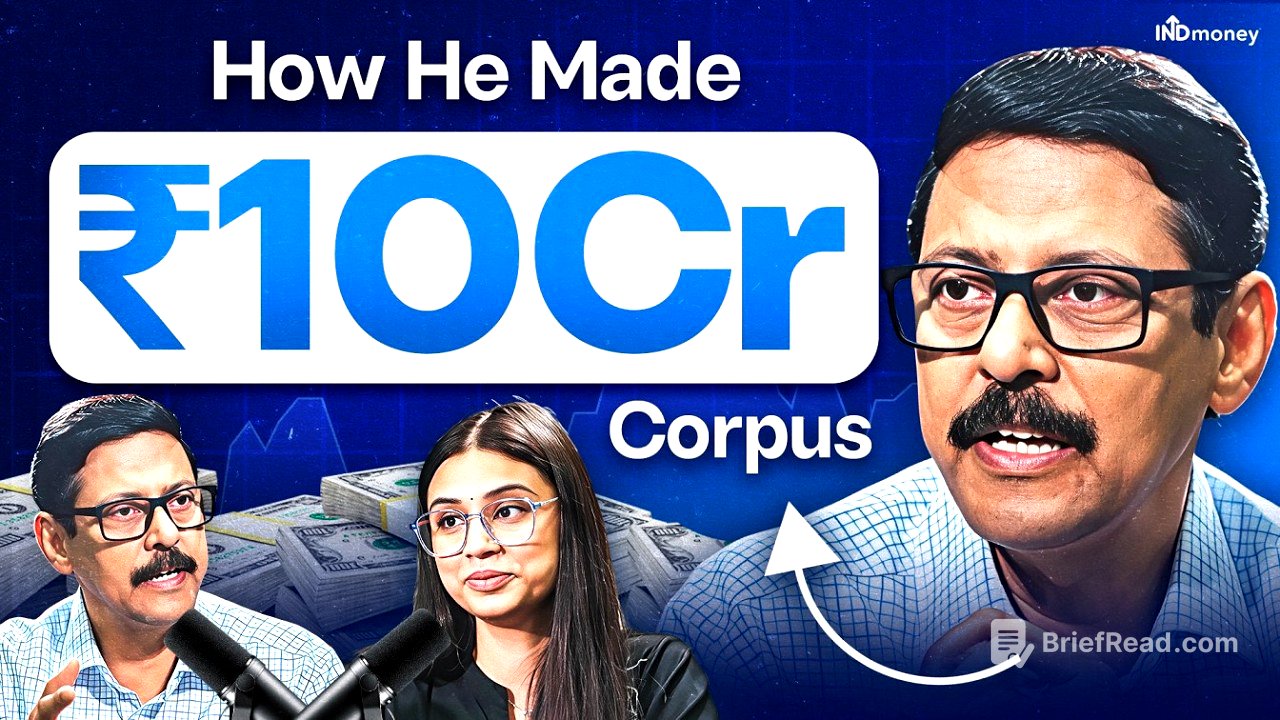TLDR;
This video features an insightful conversation with Mr. Dhirendra Kumar, founder and CEO of Value Research, focusing on building net worth and crafting a robust mutual fund portfolio. Key takeaways include:
- Building a corpus involves disciplined spending and aligning lifestyle expectations.
- Starting early with investments, even small amounts, is crucial for habit formation.
- Selecting the right mutual fund involves understanding your investment goals and risk tolerance.
- Diversification is key to mitigating risk and ensuring long-term growth.
- Investors should focus on their own financial discipline and avoid chasing market trends.
Introduction [0:00]
The video introduces Mr. Dhirendra Kumar, founder and CEO of Value Research, with the aim of providing viewers with guidelines on building their net worth and mutual fund portfolios. The discussion promises to cover the dos and don'ts of investing, drawing from Mr. Kumar's 30-35 years of experience in the field.
What is Dhirendra Kumar’s actual net worth and how did he build his first ₹1 crore? [1:27]
Dhirendra Kumar shares that his net worth is more than enough for his lifetime consumption. He built his first ₹1 crore in about 10-12 years, primarily by reinvesting his earnings from Value Research back into the company. He emphasizes that his personal net worth doesn't fully reflect his earnings due to this reinvestment.
What portfolio or investing strategy changes did he make after reaching ₹1 crore? [4:20]
After reaching his first crore, Dhirendra Kumar maintained a disciplined approach to spending and lifestyle expectations. He avoided being swayed by societal pressures to upgrade his lifestyle, which allowed him to continue growing his wealth. He focused on objective spending and prioritized saving and investing.
When should someone start investing, and what checklist should they follow before starting? [7:44]
Mr. Kumar advises starting investing as early as possible to form good financial habits. He outlines a checklist to follow before investing:
- Ensure you have enough for essentials: Prioritize meeting your basic needs before investing.
- Control spending: Live within your means and avoid unnecessary expenses.
- Emergency fund: Build an emergency fund to cover unexpected expenses.
- Insurance: Secure adequate life and health insurance.
- Clear financial goals: Define your investment goals and time horizon.
How can you select the right mutual fund for your investment goals? [13:12]
Selecting the right mutual fund involves understanding your investment goals and risk tolerance. Mr. Kumar simplifies the process by categorizing investment needs:
- Money for a few days: Liquid funds are suitable.
- Money for a few years (2-3 years): Invest in fixed income funds for predictable returns, especially for non-negotiable goals. Conservative hybrid funds can be considered for negotiable goals.
- Money for many years (5+ years): Depending on risk appetite, consider aggressive hybrid funds, multi-cap funds, or flexi-cap funds. Venture-some investors may consider mid- and small-cap funds.
He advises against investing in sectoral or thematic funds and recommends starting with SIPs to acclimatize to market volatility. Choose funds that beat their benchmark on a 5-year basis and have the lowest expense ratio.
Should retail investors worry during market uncertainty or volatility? [19:02]
Mr. Kumar advises retail investors not to be overly concerned about market uncertainty or volatility. He suggests focusing on long-term investment goals and maintaining a disciplined approach. He emphasizes that market fluctuations are normal and that investors should avoid making impulsive decisions based on news or short-term market movements.
Is it really possible to make ₹1 crore with an SIP of ₹5,000 per month? [21:07]
Mr. Kumar confirms that it is realistic to make ₹1 crore with a ₹5,000 SIP. He suggests starting with a small amount and gradually increasing it with income increments. The key is to form the habit of saving and investing. The value of a ₹5,000 SIP is not just the monetary amount but the demonstration of financial discipline and the impact it has on one's mindset.
How do I diversify my portfolio to avoid fund overlap? [23:49]
To diversify your portfolio and avoid fund overlap, Mr. Kumar recommends choosing diversified vehicles like multi-cap or flexi-cap funds. These funds provide exposure to a wide range of companies across different market segments. He also suggests considering funds with different investment styles (growth vs. value). To assess overlap, he recommends using Value Research's online portfolio tracking tool.
What are 3–4 key signals to identify the right mutual fund for investment? [26:19]
Key signals to identify the right mutual fund:
- Define your investment needs: Money for a few days, a few years, or many years.
- Diversification: Choose funds that offer broad market exposure.
- Performance: Look for funds with a 4- or 5-star rating on Value Research.
- Benchmark: Select funds that have beaten their benchmark in 3- and 5-year periods.
- Expense Ratio: Among the top-performing funds, choose the one with the lowest expense ratio.
Are passive funds, index funds, and ETFs reliable long-term investments or just a trend? [28:02]
Mr. Kumar believes that passive funds, index funds, and ETFs are sustainable investment instruments, not just a trend. He notes that index funds have become the default instrument for employee provident funds. While individual investors may be drawn to the stories and potential magic of active funds, index funds are a good way to start if you're unable to decide or do the research required for active fund selection.
Is theme-based investing (AI, ESG, EV, etc.) sustainable or risky? [32:53]
Mr. Kumar views theme-based investing (AI, ESG, EV, etc.) as potentially risky and not as sustainable as broad-based index funds. He compares them to consumer products created to appeal to people's aspirations and greed. He advises keeping it simple, boring, and diversified, and entrusting your money to a good fund manager or an index fund.
How often should I update my SIP strategy or rebalance my mutual fund portfolio? [34:22]
Mr. Kumar suggests not making any changes to your SIP strategy for the first three years. After that, do an annual check, looking at whether the fund is beating its benchmark and has a 4- or 5-star rating. Portfolio rebalancing, which involves asset allocation, should only be considered after five years of investing, once you have a meaningful amount invested.
What is the right way to balance my investments between equity and debt? [37:01]
Mr. Kumar explains that balancing investments between equity and debt involves asset allocation, which is like buying an insurance policy to mitigate regret when the market goes down. He suggests a 20/80 equity-to-debt ratio for new investors, gradually increasing equity exposure as they become more comfortable with market volatility. For retirement planning, he recommends adjusting the ratio based on proximity to retirement, with a higher allocation to debt as retirement approaches.
What is Dhirendra Kumar’s most important advice for investors today? [41:12]
Mr. Kumar's most important advice is to get started now, do your job well to keep earning, and follow your own rules, beliefs, confidence, discipline, patience, and plan. He advises against listening to others or expecting a secret formula for success. He emphasizes that your own financial discipline is the biggest driver of your performance.









